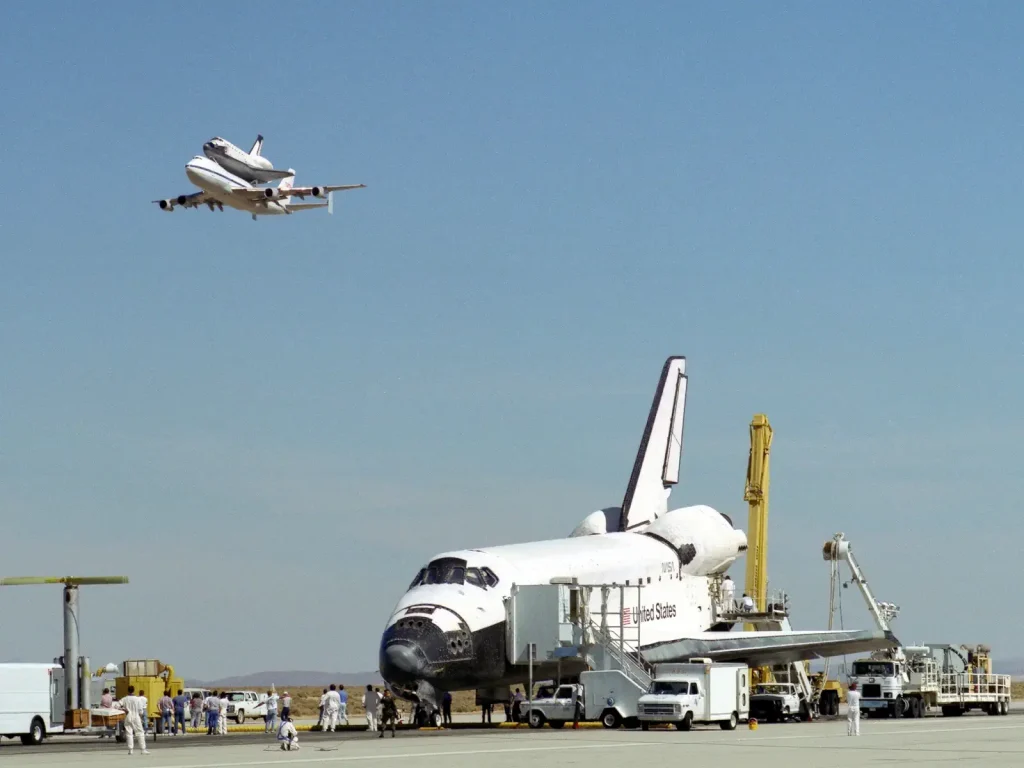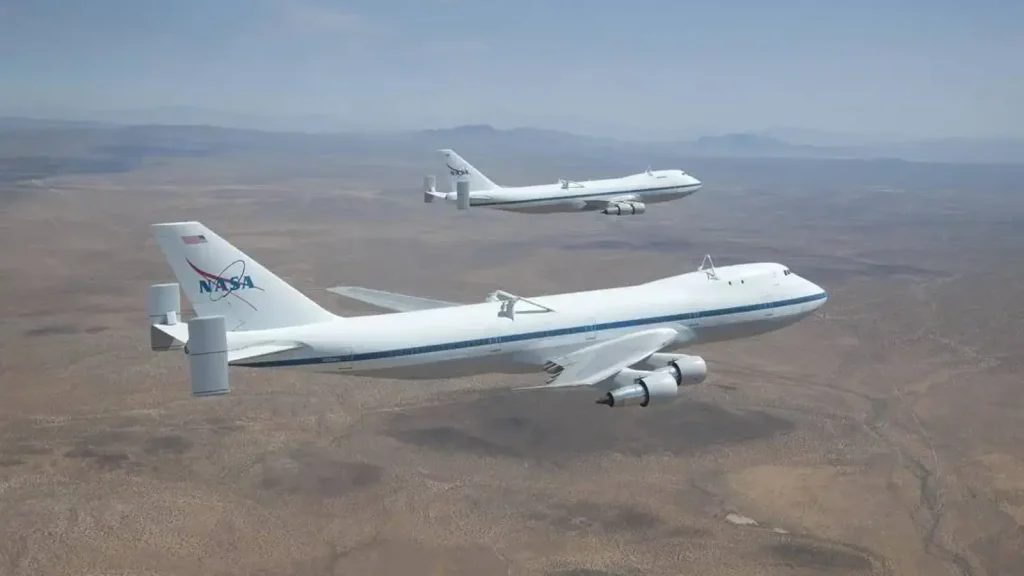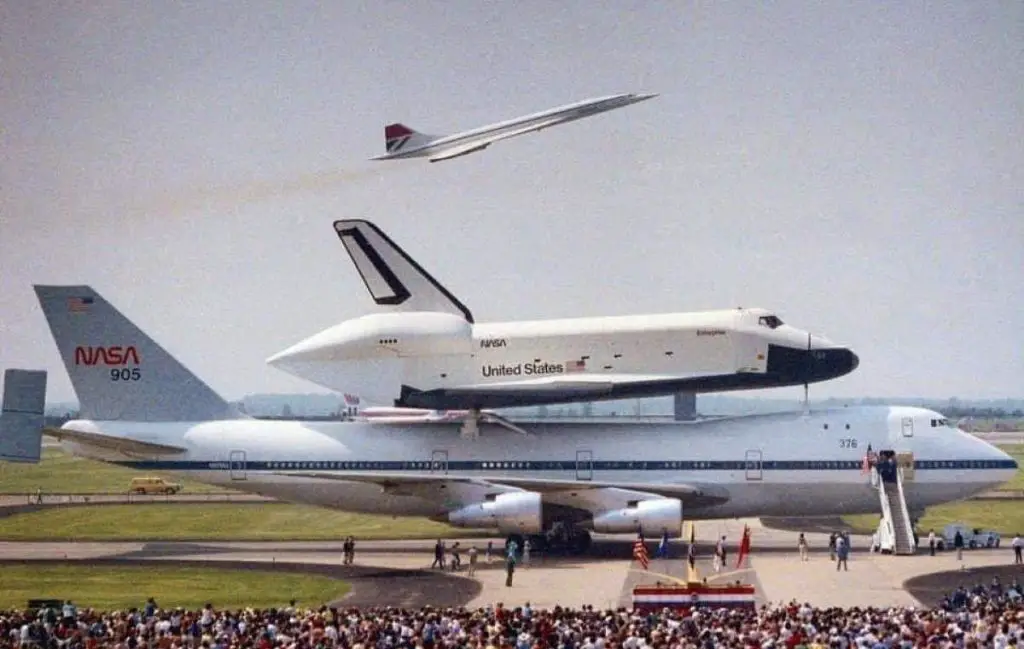An amazing photo from the past: The space shuttle Endeavour receives a high-flying salute from its sister shuttle, Columbia, atop NASA’s Shuttle Carrier Aircraft, shortly after Endeavour’s landing on October 11, 1994, at Edwards, California, to complete mission STS-68. Columbia was being ferried from the Kennedy Space Center, Florida, to Air Force Plant 42, Palmdale, California, where it will undergo six months of inspections, modifications, and systems upgrades. The STS-68 11-day mission was devoted to radar imaging of Earth’s geological features with the Space Radar Laboratory. The orbiter is surrounded by equipment and personnel that make up the ground support convoy that services the space vehicles as soon as they land.

STS-68, known as Space Radar Laboratory-2 (SRL-2), was a pivotal mission for NASA, launched on September 30, 1994, aboard the Space Shuttle Endeavour. This mission was part of NASA’s ongoing efforts to study and understand Earth’s environment and geological features from space. Utilizing the sophisticated Spaceborne Imaging Radar-C/X-Band Synthetic Aperture Radar (SIR-C/X-SAR), STS-68 embarked on an 11-day journey to capture high-resolution images of Earth’s surface.
The radar system was designed to penetrate through vegetation, clouds, and dry sand to reveal hidden structures below, providing invaluable data for studies in geology, ecology, hydrology, and oceanography. The success of STS-68 contributed significantly to the scientific community, offering insights into the processes shaping our planet and enhancing our capability to monitor and manage Earth’s resources.
NASA’s Space Shuttle Carrier
NASA’s Space Shuttle Carrier, a modified Boeing 747, is an iconic example of aerospace ingenuity and a key element in the history of space exploration. Officially known as the Shuttle Carrier Aircraft (SCA), this aircraft was specially adapted to transport the Space Shuttle orbiter between landing sites and the Kennedy Space Center, or to other locations where a shuttle might need to be moved, such as the Palmdale facility in California where the shuttles were built.
The need for the Shuttle Carrier Aircraft arose because the Space Shuttle, designed for space, was not capable of flying back to the Kennedy Space Center if it landed at an alternate site. This could happen due to bad weather or technical reasons necessitating an unplanned landing. The SCA solved this problem by allowing the orbiter to be piggybacked on the aircraft, facilitating its return to Florida or its transportation for maintenance and preparation between flights.
Two Boeing 747s were converted into SCAs. The first was a 747-100 purchased from American Airlines, designated NASA 905, and the second, NASA 911, was acquired later to ensure operational efficiency and redundancy. The modifications to the 747s were extensive and included the removal of the interior furnishings to save weight, the strengthening of the fuselage to bear the shuttle’s weight, and the addition of support struts and mounting points on the aircraft’s back. These modifications enabled the 747 to carry the orbiter, which was attached to the SCA using a complex three-point harness system that distributed the shuttle’s weight evenly across the aircraft’s frame.
The SCA and orbiter combination was an impressive sight. The orbiter was positioned with its nose pointing forward and its tail fin removed to reduce aerodynamic drag. This configuration required significant modifications to the 747’s flight systems to account for the altered aerodynamics, including adjustments to the elevators, and engines, and the addition of vertical stabilizers on the tail to enhance stability during flight.

Operational flights of the SCA with an orbiter were conducted at relatively low altitudes and speeds, typically not exceeding 15,000 feet and 250 knots, to ensure safety and minimize stress on both the 747 and the shuttle. Despite the careful modifications, the added drag and weight of the orbiter significantly affected the 747’s performance, reducing its range and requiring careful planning and execution of ferry flights.
The SCA played a crucial role in the Space Shuttle program, enabling NASA to efficiently manage the logistics of shuttle operations. It was used not only for post-landing returns to Kennedy Space Center but also for delivering orbiters to launch sites and facilitating other logistical movements required by the program. After the retirement of the Space Shuttle fleet in 2011, the SCAs were also used to deliver the orbiters to museums across the United States for public display, marking the end of their operational life but not their significance in the history of space exploration.
Sources
- STS-68 on Wikipedia
- STS-68 mission on the NASA website
- Shuttle Carrier Aircraft on Wikipedia
- Shuttle Carrier Aircraft on the NASA website [PDF]
- Budget of NASA, Year by Year [1980-1989] - June 10, 2024
- Budget of NASA, Year by Year [1970-1979] - June 10, 2024
- Budget of NASA, Year by Year [1958-2024] - June 10, 2024

